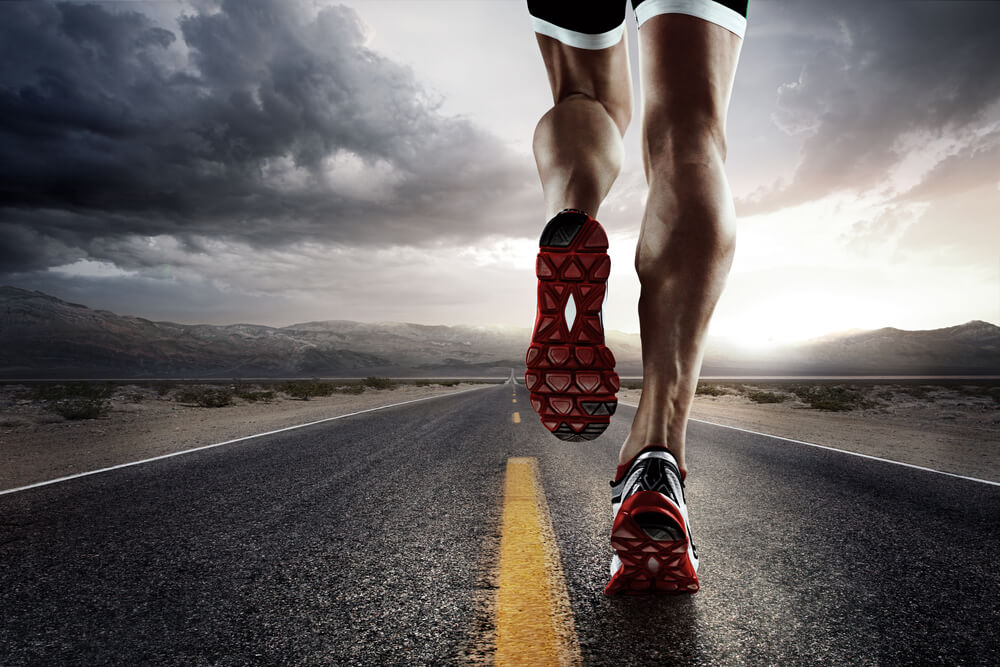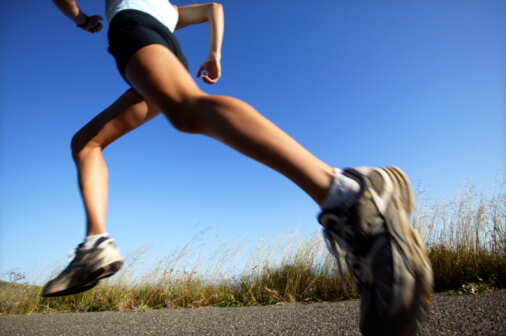
If I asked you whether you knew how to run, would you roll your eyes at me?
Well, there is more to it than just our instinctive natural stride. In fact, there is a proper way to run that will improve your breathing and increase the benefit your body takes from the exercise. Today, we’ll look at running in detail and give your homemade wheels a tune-up. You will also learn how to avoid injury as best a possible, a recent study concluded that long-distance runners are more prone to injury.
As with any exercise, when you don’t focus on proper form, you may end up damaging your body. When you are running long distances, the odds of being hurt are going to increase considerably.
So to avoid that and keep you performing at your best, I’ll cover how to run properly for different length workouts. I will also touch on why interval running is my preferred method.
My Love of Running
Since I first started working out, running was always a great way to clear my head and burn some calories. Even though there are plenty of highly efficient ways to train with running, I’ll never completely write off the old fashion jog—even if just to help you de-stress.
Over the years, my exercise strategies have diversified. I don’t do as much distance running but having a proper running form has been especially helpful with interval training, parkour, trail runs and charity runs.
Do You Really Want To Run?
This is a serious question. If you don’t really want to run, you will very likely fail to stick with a plan. I can tell you how to jog properly, but the fire to run has to come from within. It’s not easy and the workouts don’t allow a lot of shortcuts. If you’re just looking to burn some extra calories, running may not be your answer. If you want to challenge yourself to run a 5k, half marathon, full marathon etc, then your stride and posture must be locked in.
What Do I Need To Do First?
We all love to check out new sneakers and gear before a beginner workout routine, but there are a few things to consider first.
Before you start with running, there is a base fitness level your body should be at in order to run healthily. Running puts a good deal of stress on your muscles, bones and tendons so make sure that any past injuries have been cleared by a doctor before running.
If your body is not ready to run, it’s perfectly smart to start with lower impact activities like hiking, swimming, walking, biking, and elliptical machines. These will train your aerobic energy system without pounding on your joints as much as running. You can also use these activities to build a foundation as you prepare to run.
How To Warm Up Properly
You can’t stretch a cold muscle, so you might as well save yourself the trouble. A dynamic warm-up is the key to preparing your muscles for rigorous activities.
The best way to do this, is to set about a 15 yard distance and go back and forth mixing up jogging, high knees, high kicks, shuffles, bear crawls, mountain climbers and anything you can think of to move your body and warm the muscles before intense running.
Proper Running Form
Have you ever taken video or photos of your stride to examine your form? Do you know which part of the foot should hit the ground first and the kind of angle your knee should bend at? These are important details as you learn the proper way to run.
Spending a little extra cash to get high quality running shoes fit to your specific bone structure can definitely help. Always try to find running stores that measure and analyze your step before recommending a pair of shoes.
When you are running in cushioned shoes, the ankles and get needed support from the shoes. However, too much support can cause the tendons to get complacent from lack of stress.
Some people have a tendency to hit the ground flat with their feet when running. With highly cushioned shoes, you may not even notice this is happening. With a flat strike, you extend your leg and thus the ankle, lower back, knees and even hips are going to experience shock wave which is not ideal.
So, think about how you would run barefoot in a natural state. You should try and take a bit shorter strides and at the same time, you should try to aim for a forefoot strike and let your legs absorb the shock uniformly. Believe it or not, many athletes do train by running barefoot—if you’re going to try this, grass is recommended.
Some believe that when people run barefoot, this enforces perfect posture as the spine will be corrected by running up on your forefeet. Also, whether you’re barefoot or not, keep the head steady and the arms swinging loose, do not flex.
The barefoot running technique is sometimes understood as running while falling forward. It requires you to maintain perfect posture and your feet should touch the ground quickly and make sure to kick your backside toward the butt. Make sure not to stomp your heels and focus on where you place your foot with each contact. The strides you take will be shorter and you’ll feel the need to keep some bend in your knees.
Initially, you may feel a little weird and maybe even uncomfortable; however, this is how developing your natural stride begins. Be light on your feet and keep a bounce in your step.

How To Run Longer & Improve Running Technique
When you are learning how to run, especially if you use barefoot running to improve your stride, you’re going to wake up sore. Parts of your feet will ache that you never knew you had. This is part of the process—remember earlier, I said you’ve got to really be willing to sacrifice in order to improve. It takes time to adjust so, here are a few tips to help you along the way as you learn how to run properly.
- Start slow: when you are first learning the art of proper running, start at the right pace and save yourself a lot of pain. When you choose the barefoot style of running, your body can get extremely tired much faster than normal. If you exert your body too much, you might end up getting injured. So, keep smart boundaries, use a soft surface, and build up to longer runs.
- Try running up hills: one of the best ways to improve the style with which you run is by taking a jog up hills. Incline creates added stress and makes flat running feel easier. This will also help you improve your running style naturally. When you are running up a hill, you will naturally take short strides and strike on your heels.
- Stay off the roads: If you can avoid them, stay off the roads. Dirt paths, grass and designated bike/walking paths are the best surfaces and provide the lowest risk of accidents.
- Cool down time: as much as the warm-up is important, it is also important to give your body ample time to cool off. Walk and bring your breath back down to normal.
Running Tips And Tricks
Here are a few more ideas to consider.
Stay Barefoot Whenever You Can
If you are comfortable doing so, you should try and stay barefoot as much as you can when you’re working on your stride. This means even just walking around your house or in the yard.
Track Your Progress
Now, what would be the use of all this running, if you don’t know whether it’s helping? This is why I would suggest that you keep a journal or use an app to track your progress and times.
Strength Training Is Key
Regardless of whether you are looking to lose weight or build muscle, the one thing that is always important is strength training. Running is going to burn your muscles along with fat. When you are looking to stay fit and maintain a strong physique, weight training will help.
Your Eating Habits
I can tell you a hundred tips and none of them will work if you aren’t eating right. Low carb diets are not going to sync well with a running plan. It is especially important after a running workout that you refuel with a high protein recovery meal, but this is also when you should be consuming starches to help build muscle and replenish glycogen stores. Lower glycemic load carbs like whole wheat, vegetables, and brown rice will help provide lasting energy sources.
Conclusion
When you’re looking to improve your stride and develop the proper way to run, these tips will help you get started. As always, you are the only person who can really do the work. Developing your stride will reduce wasted energy expenditure and help improve your times, so what are you waiting for? Get running!
-Terry Asher
Terry
Latest posts by Terry (see all)
- How Important Are Net Carbs For Building Huge Muscle? - Apr 28, 2017
- The Matt Damon Workout Explained - Apr 27, 2017
- Watercress – Benefits And The Best Way To Consume It - Apr 26, 2017











